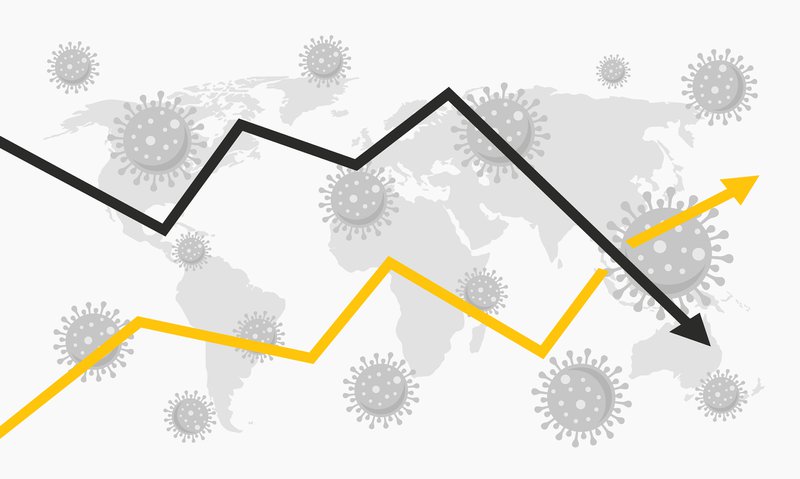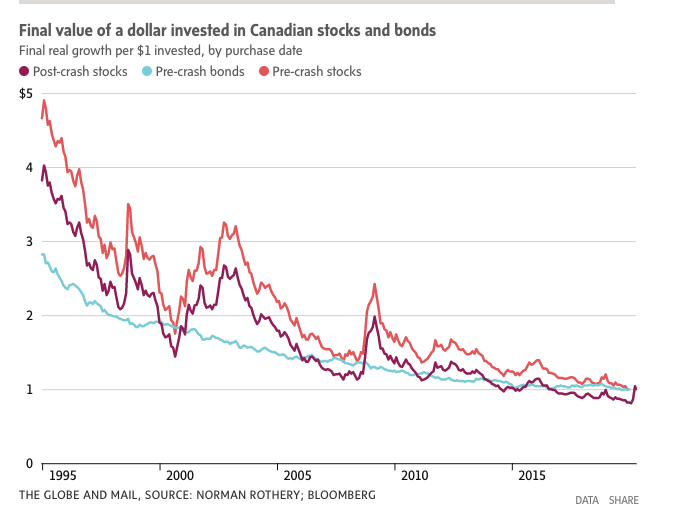
NORMAN ROTHERY
April 22, 2020
Cast your mind back to what you were doing last New Year’s Eve. If you’re like me, you might have a hard time remembering those joyful times after sheltering inside for weeks under the miasma of the virus-induced storm.
But I’m going to reminisce a bit in an effort to paint a before-and-after picture of the stock market in early 2020. The idea isn’t to frighten investors but to inspire them to look forward with a grain of hope rather than a dumpster full of dread.
Things were looking good for the markets at the start of the year. While there were some weak spots, the Canadian stock market chalked up big gains since the crash of 2008 and the longer-term numbers were solid.

The Canadian stock market, as represented by the S&P/TSX Composite Index, climbed by an average of 6.4 per cent annually from the close of 1994 to the close of 2019. Canadian bonds posted solid returns over the same 25-year period with the S&P Canada Aggregate Bond Index climbing by an average of 4.2 per cent annually. (All of the returns herein include reinvested distributions and are adjusted for inflation, which is the propensity for the purchasing power of the dollar to lose value over time. They do not include taxes, fund fees, or trading frictions.)
Many investors would be eager to sign up for 6-per-cent real returns. But the gains came with alarming crashes along the way that seemed to be unprecedented at the time.
The good and the bad can be seen in the accompanying graph, which reverses the typical view of long-term returns. The graph plots the final return of a dollar invested at various points in the past. The pre-crash lines represent returns through to the end of 2019 while the post-crash line tracks the results through to the close of April 15, 2020. (The bond line didn’t change much from pre-crash to post-crash.)

Focus first on the pre-crash results. Each dollar invested in the bond index at the end of 1994 grew to $2.82 by the end of 2019. Similarly the stock index grew each dollar to $4.66 over the same period. (Again, both include reinvested distributions and they adjust for inflation.)
The bond index provided a much smoother ride than the stock index over the 25 years, just as one would expect. But bonds generally offered lower returns.
The impact of stock market tops, and bottoms, can be seen in the gains of the stock index. An investment at the Nortel-fuelled highs in August, 2000, grew each dollar invested to $1.75 by the end of 2019. A bond index investment over the same period fared better with an ending value of $1.83. It represents one of the rare starting periods when the bond index won the race.
Buying in bad times was profitable for stock investors. For instance, the stock index turned each dollar invested in September, 2002, into $3.25 by the end of 2019 while a bond investment produced $1.64 over the same period.
Buying stocks when the markets were at their most frightening proved to be better than buying when the outlook was rosy, which brings us to more recent times. The post-crash burgundy line on the graph shows how much each dollar invested would have grown through to the close of April 15, 2020.
(I hasten to add that I don’t know whether the stock index has already hit the low for the current downturn or if the low is still to come.)
The crash pushed the stock index’s return line down sharply compared with the results measured through to the end of 2019. The plummet in March, and subsequent partial rebound, knocked about 18 per cent off the stock market’s year-end returns.
Looking back at the prior 25 years, it is clear that investors benefited from buying stocks in down periods. More than that, they didn’t have to time their purchases to perfection to do quite well. Simply buying when others were fearful yielded good results for investors who had the fortitude to hold on through the storms that buffeted them.
This Globe and Mail article was legally licensed by AdvisorStream.
© Copyright 2024 The Globe and Mail Inc. All rights reserved.


